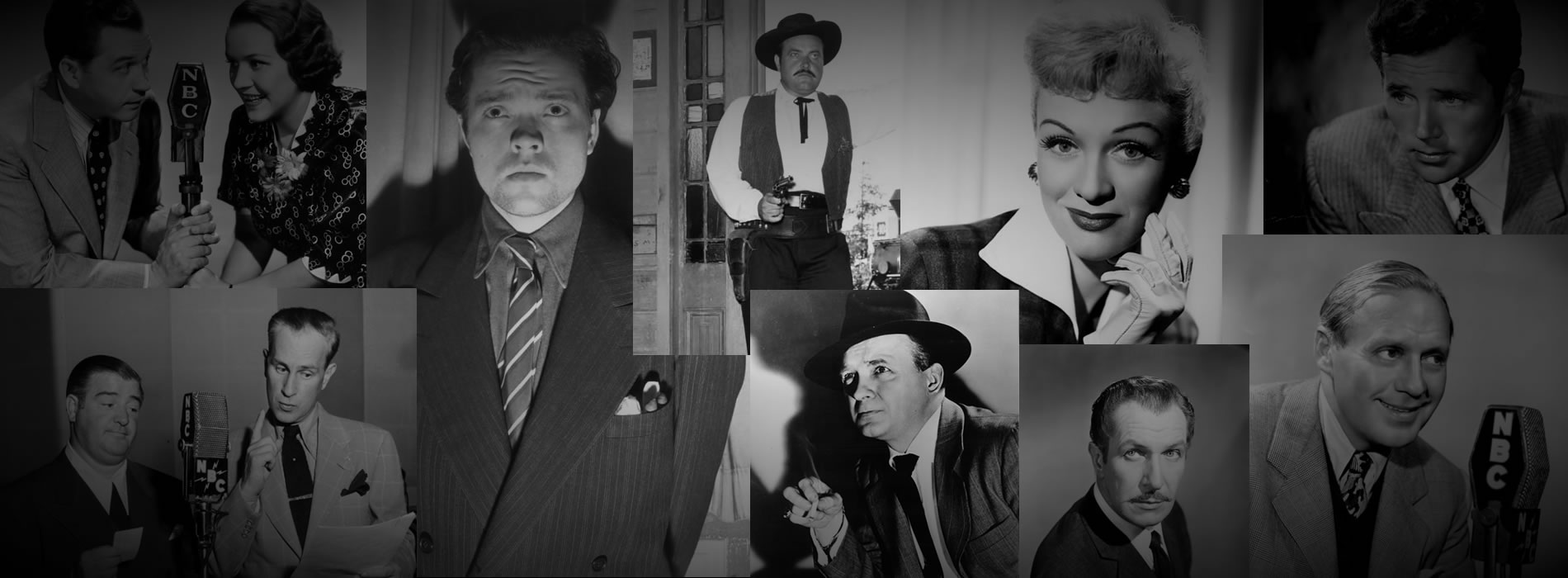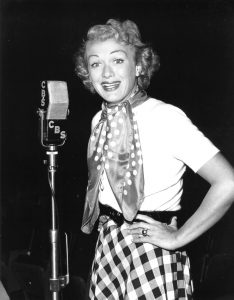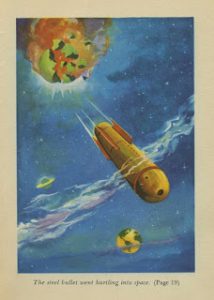
NEWSLETTER | VOL. 15, July 2022
Welcome to this month’s edition of The Hollywood 360 Newsletter, your place to get all the news on upcoming shows, schedule and interesting facts from your H360 team!
Carl’s Corner
by Carl Amari
Hello everyone – here’s the Hollywood 360 newsletter, July 2022 / Vol. 15. As someone on our mailing list, you’ll receive the most current newsletter via email on the first day of every month. If you don’t receive it by the end of the first day of the month, check your spam folder as they often end up there. If it is not in your regular email box or in your spam folder, contact me at carlpamari@gmail.com and I’ll forward you a copy. The monthly Hollywood 360 newsletter contains articles from my team and the full month’s detailed schedule of classic radio shows that we will be airing on Hollywood 360. Each month I’ll provide an article on one of the classic radio shows we’ll present on Hollywood 360. The week of July 2nd, 2022 we’ll be airing a comedy episode of Our Miss Brooks starring Eve Arden so here’s an article on this wonderful radio series. Enjoy!
Our Miss Brooks
By Carl Amari and Martin Grams
Eve Arden is best known for playing sassy Connie Brooks, lovesick schoolteacher of Madison High, in the weekly radio and then TV sitcom, Our Miss Brooks. Miss Brooks taught English to tenth-graders and was loved by real schoolteachers and students who tuned in each week and could relate. Apparently incapable of temperament, she found herself trying to resolve comical situations at Madison High, usually clashing with Principal Osgood Conklin, played by versatile actor, Gale Gordon (who would later gain greater fame as Lucy’s boss Mr. Mooney).
Premiering on CBS Radio in 1948 and lasting until 1957, Our Miss Brooks made a successful transition to television in 1952. Joining the barnyard antics at Madison High was Walter Denton (Richard Crenna) a student trying to leave his mark on the world. Whether he started a campaign to improve the food in the school cafeteria or push to have Miss Brooks named “Teacher of the Year,” he rationalized the practical applications to Miss Brooks, who agreed to help the cause. Walter’s relationship with Principal Conklin’s daughter was disdained by Conklin himself, who took every opportunity to blame Miss Brooks for the pairing.
Miss Brooks had eyes for Philip Boynton (played on radio by Jeff Chandler and Robert Rockwell and on TV by Rockwell) the bashful biology teacher, a science nerd who never took time to learn about the birds and the bees. In one episode, Miss Brooks starts a quarrel with Mr. Boynton so a loving reconciliation could take place. Her efforts are in vain when the biology teacher proves he only has eyes for his pet frog, McDougall.
In 1956, Warner Brothers released a big screen movie based on the radio and TV programs, with most of the television cast reprising their screen roles. The movie featured an origin for Miss Brooks’ arrival at Madison High. The film closed with Miss Brooks succeeding in capturing the affections of Mr. Boynton resulting in a wedding between the school teachers. Sadly, the radio and TV program never had this union.
During the sixties, Arden raised a family, even naming one of her three daughters “Connie.” In 1967, she made her comeback with The Mothers-In-Law, another situation comedy that was successful enough to run two seasons. Arden followed this with a number of unsold television pilots, made a number of guest appearances on other television programs and pleasantly surprised moviegoers when she appeared in the role of Rydell High School’s Principal McGee in Grease (1978) and in Grease 2 (1982).
LEND ME YOUR EARS | THIS MONTH’S SONG: Me and Bobby McGee by Janis Joplin, RELEASED: 1971
by Lisa Wolf
“Fred Foster…called me and said, ‘I’ve got a title for you: ‘Me and Bobbie McKee,’ and I thought he said ‘McGee.’ I thought there was no way I could ever write that, and it took me months hiding from him, because I can’t write on assignment. But it must have stuck in the back of my head.” ~ Kris Kristofferson
 On January 11, 1971, Janis Joplin’s Me and Bobby McGee was released as a single. Her song is a cover version of Kris Kristofferson and Fred Foster’s original song. Janice Joplin’s version came out just four months after she died, which was on October 4, 1970, at the age of 27. Me and Bobby McGee went on to become Joplin’s only number-one single, which was released on her posthumous album Pearl. The song was meant to be called Me and Bobby McKee. Kristofferson later recalled that he thought he heard “McGee,” and so he named it accordingly. Click here to listen on Youtube.
On January 11, 1971, Janis Joplin’s Me and Bobby McGee was released as a single. Her song is a cover version of Kris Kristofferson and Fred Foster’s original song. Janice Joplin’s version came out just four months after she died, which was on October 4, 1970, at the age of 27. Me and Bobby McGee went on to become Joplin’s only number-one single, which was released on her posthumous album Pearl. The song was meant to be called Me and Bobby McKee. Kristofferson later recalled that he thought he heard “McGee,” and so he named it accordingly. Click here to listen on Youtube.
So, who is Bobby?
What people don’t know is that Bobby was actually a woman and friend of Foster. The ambiguity of the name Bobby worked to his advantage, as it made it easy for both male and female singers to cover. Roger Miller, Dolly Parton, Gordon Lightfoot and Kenny Rogers all did their own versions before Janis Joplin.
 Ironically, her death led to the album getting worldwide attention, sending it to the top of the charts. Me and Bobby McGee became the second song ever in the US to hit number one after the singer has died. The other was was Otis Redding’s Dock of the Bay.
Ironically, her death led to the album getting worldwide attention, sending it to the top of the charts. Me and Bobby McGee became the second song ever in the US to hit number one after the singer has died. The other was was Otis Redding’s Dock of the Bay.

SUPERMAN
by Martin Grams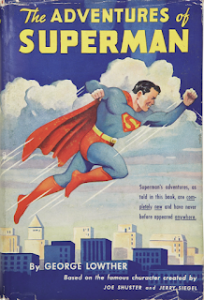
Amongst the mythos of Superman are a number of trademarks which, to those who never read the comic books, originated from radio. Perry White, Jimmy Olson and Kryptonite was introduced to The Adventures of Superman radio program long before they made their first appearance in the comic book rendition, and the unsung hero was not Jerry Siegel and Joseph Shuster – it was George Ludlam, Robert Maxwell, Edward Langley and George Lowther. The latter of whom was responsible for scripting such radio programs as Dick Tracy, Terry and the Pirates and Renfrew of the Mounted, and to whom we are taking a quick moment to revisit.
Born in 1913, Lowther proclaimed to being the first page boy (at the age of 14) hired by NBC Studios in New York City, and his flair for words meant his scripts were sharper than those of his colleagues. Lowther would eventually maintain continuity and portray the man in tights as a heroic American who combatted the enemies who attempted to commit acts of sabotage during World War II. As Edward Langley once remarked, “Lowther basically was Superman Incorporated.”
Lowther reportedly wrote the majority of the radio scripts for the first Superman radio program, which was syndicated beginning in February of 1940 and ran a total of 325 episodes. Among the regional sponsors were Hecker’s Oat Cereal and Force Wheat Flakes. Because the series was recorded, transcribed and syndicated, the program aired on various days and time slots. In one area of the country the program was heard three times a week at 7 p.m., while in other areas the program was heard five nights a week at the 5 o’clock hour. (Today, all 325 episodes and the four audition recordings are known to exist in recorded form.) Many of the story arcs were adapted for Radio Mirror magazine for short stories. I was lucky enough to acquire a zerox of most of those stories and you can enjoy reading them here.
In 1942, The Adventures of Superman made a return to the airwaves, this time as a network program, five nights a week, over the Mutual Broadcasting System. A total of 1,612 broadcasts aired from 1942 to 1949, with the earliest episodes rehashed and recycled from the syndicated run, and by episode thirteen entirely new stories were created for the program. By this time George Lowther was not only involved with the script writing, but also the directing (and for more than a year, announcing chores as well). Lowther was eventually provided an assistant to handle the script writing, Edward Langley, to ease his position of wearing many hats.
In 1942, Random House published a hardcover (with dust jacket) for Superman, a prose novel with illustrations by Joe Schuster. George Lowther wrote the novel during the downtime between the two radio programs. Lowther recycled the origin of Superman, how he comes to Earth and getting a job working for the Daily Planet, providing considerable detail when Clark Kent first discovered he had abilities beyond mortal men. Among the noticeable trademarks of the origin story (segments of which are also depicted on the radio program) was Eben and Sarah Kent, his adopted parents. Today, through studio and corporate branding, the names of Jonathan and Martha Kent are more familiar to television and movie goers.(not nationally)
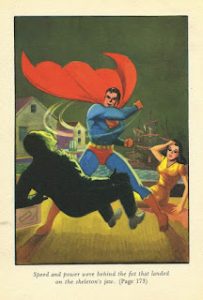 To eliminate confusion, and to provide clarity: Eben and Martha Kent were the names used in the 1948 cliffhanger serial produced by Columbia Pictures, while Eben and Sarah were used for the 1952 television rendition. In the comic book’s first extensive retelling of Superman’s origin (Issue #53, July-August 1948), the names were John and Mary Kent. Later stories, after the early 1960s introduction to the DC Multiverse, declared that the early renditions of the Kents were indeed John and Mary Kent (eliminating any reference to Sarah from the radio program and the 1942 novel) and live in the “Earth-Two” universe while Jonathan and Martha live in the “Earth-One” universe.
To eliminate confusion, and to provide clarity: Eben and Martha Kent were the names used in the 1948 cliffhanger serial produced by Columbia Pictures, while Eben and Sarah were used for the 1952 television rendition. In the comic book’s first extensive retelling of Superman’s origin (Issue #53, July-August 1948), the names were John and Mary Kent. Later stories, after the early 1960s introduction to the DC Multiverse, declared that the early renditions of the Kents were indeed John and Mary Kent (eliminating any reference to Sarah from the radio program and the 1942 novel) and live in the “Earth-Two” universe while Jonathan and Martha live in the “Earth-One” universe.
The 1942 Lowther novel also reveals how Superman will have the power to fly on Earth, “but must walk a snail’s pace on the Earth’s surface” to avoid disclosing his ability of speed. Superman could also breathe under water.
The second half of the book contains an original story about a skeleton ship reported along a Maine shipyard. The rumored ghostly specter included a crew from Davy Jones’ locker, haunting men away from their jobs at the nearby Lowell Shipyard, constructing vessels for the war effort. Clark Kent, sent on his first routine job as a reporter for the Daily Planet, was sent up north to investigate. There, he shrewdly combines his efforts with reporter Lois Lane, while investigating solo to avoid revealing his super-human capabilities.
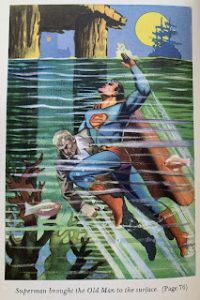 The underwater menace was a number of enemy submarine stationed offshore, ready to attack, and the ghost-like figures were merely meant to frighten workers away from the docks to cripple war production.
The underwater menace was a number of enemy submarine stationed offshore, ready to attack, and the ghost-like figures were merely meant to frighten workers away from the docks to cripple war production.
“The skeleton ship with its crew leering down from the rail was a sight to set the strongest nerves quivering. A brief glimpse of it might be enough to send this girl into hysterics. Also there was Captain Joshua Murdock – a skeleton clothed in the tattered and moldy remains of clothes more than a century old – who prowled the pier at night and who no doubt would make his appearance before dawn…”
Elements from this story was dramatized on the radio program in the story arc known as “Last of the Clipper Ships,” syndicated in March and April of 1941. In that story, Clark Kent and Jimmy Olsen were sailing on the Clara M (not the Nancy M), last of the clipper ships. Mr. Barnaby, a one-legged sailor, and the mysterious “Whistler” make trouble for Captain Hawkins. Other elements from the same novel were used in “The Mystery Ship” (December 1942, MBS), involving “the Old Man of the Seaweed.” Regardless of elements borrowed, the story in the novel is an original and not one heard over the radio program.
Gavel price for George Lowther’s Superman varies based on marketplace. The dust jacket is worth more than the book but the demand for the hardcover is strong enough to ensure even the book has strong value. A facsimile edition was published in 1995 by Applewood Books, with a new introduction by Roger Stern, also available in hardcover. (You can tell the difference between the original and the facsimile by the front cover which discloses that the original was published in 1942 and with the new Introduction.) The reprint sells between $10 and $50, depending on who is selling it but never spend more than $20 with postage. As for the original, the red hardcover (without dust jacket) usually sells for about $75. The price goes up considerably based on the condition of the dust jacket.
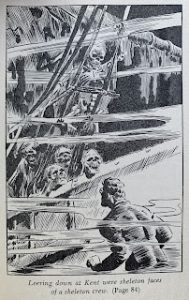 If you are looking for further information about Superman on radio and television, look no further than Michael Hayde’s fantastic book, Flights of Fantasy. Click this link.
If you are looking for further information about Superman on radio and television, look no further than Michael Hayde’s fantastic book, Flights of Fantasy. Click this link. 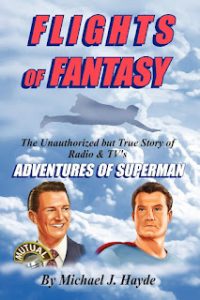

OBSESSION: AN
by Karl Schadow
The classic radio programs Suspense, Retribution and Dark Venture, among others comprised a group of psychological dramas which presented a broad spectrum of human attitudes and emotions. In addition to these thrillers, another program sporting a one-word moniker receives its due recognition in this article: Obsession.
This syndicated series was packaged and distributed by the C. P. MacGregor Company, head by C. P. ‘Chip” MacGregor. Beginning his career in the industry in San Francisco during the late 1920s he was associated with H. E. Ingram, then later partnered with S. A. Sollie. In 1936 they moved their firm to Hollywood. The following year MacGregor purchased Sollie’s share of the business. As one of the major players in the transcription field, MacGregor produced numerous music, variety and dramatic entities including The Henry King Show, Skippy Hollywood Theater and Proudly We Hail.
In 1947, MacGregor created a new series of psychological dramas which was bestowed the title: Obsession. Serving as host, MacGregor introduced each of the thirty-minute thrillers with an assessment of the episode’s human attitudes and emotions. One of the more compelling discourses, from “The Hangman” (Episode #10) intimated: “Avarice – greed. These are the slow poisons that saturate the most brilliant mind until it becomes dark and spongy – a cavern of foul and nauseous thoughts, hidden away from the light of sun. A secret place where no longer live the clean structures of love or honor, or decency, as the twisting root so of destruction dig deeper and stronger interlocking like the fibers of some malignant cancer.”
It is unknown if MacGregor wrote these expositions or whether they were crafted by the scriptwriters. This cadre included Tru Boardman, Roger Quayle Denny and Jerome Lawrence (of Lee & Lawrence) among others. The music theme of Obsession may remind you of Suspense with its climatic crescendos and use of chimes. Either Mahlon Merrick or Eddie Skrivanek composed and conducted this integral component of each drama.
Prominent stars of stage, screen and radio were selected as the headliners for the series. While listeners were captivated by the performances of Vincent Price, Elliott Lewis and Rosemary DeCamp, others who made rare appearances before the microphone were Elaine Barrymore and Eric von Stroheim. Supporting cast members were culled from Hollywood’s Radio Row including Lurene Tuttle and William Conrad.
Of the 78 episodes produced, less than half are in general circulation. An example is “Lost in the Storm” (Episode #20). Click here to watch on YouTube.
It featured William Gargan, best-known in the aural medium for his portrayal of private investigators Ross Dolan and Barrie Craig. The title of this chapter not only forewarns of the weather encountered by Gargan who enacts the role of aviator Ted Jordan, but also his relationships with wife Mary (Mary Jane Croft), fellow pilot Wade McCrary (Howard McNear) and airport employee Sparks (Peter Leeds). During his narration of the episode, Chip MacGregor repeatedly acknowledged the ‘clinging hate’ which plagued Jordan. (Not surprisingly, this phrase has often been incorrectly assigned as the episode’s title.)
Though many sources state erroneously that the series debuted during the 1950s, it was actually offered by the MacGregor firm as early as 1947. In September of that year, Cincinnati station WKRC was one of the first to schedule the program. The Bruckmann Company promoting its Bruck’s Beer brand was the bankroller. Another brewery C. Schmidt & Sons, Inc. sponsored the series on several New England stations including WGAN and WLBZ in Maine. Though the series aired on WBBM (the CBS outlet in Chicago) it was not a designated program of that network. Listeners in Canada (CHUB, Vancouver) and Hawaii (KGU, Honolulu) were also enthralled by these productions.
MacGregor continued to offer Obsession throughout the 1950s. Many of the extant episodes are available as a result of discs retained from the Armed Forces Radio & Television Service which distributed the program around the world into the 1970s.
Acknowledgment: The author thanks the staff of the National Audio Visual Conservation Center of the Library of Congress for their invaluable assistance. Contact author at khschadow@gmail.com
Hollywood 360 Schedule
7/2/22
The Bob Hope Show 3/19/46 From Cleveland, Ohio
Crime Classics 2/3/54 The Incredible History of John Shepard
Let George Do It 10/24/46 The Brooklyn Orphanage
Our Miss Brooks 7/3/49 Fourth of July at Eagle Springs
This Is Your FBI 9/12/47 Innocent Witness
7/9/22
Lights Out! 8/10/43 Sakhalin
Duffy’s Tavern 3/9/51 The Hypnotist
Broadway Is My Beat 9/15/51 Anna Compton Case
Fibber McGee & Molly 10/23/45 Cousin Ernest Comes for a Visit
The Lives of Harry Lime 10/15/52 Bentley’s Boo-Boo Case
7/16/22
Suspense 9/21/44 The Bluebird of Bellac
The Adv. of Maisie 11/23/50 Maisie’s Birthday Present
Cloak & Dagger 6/25/50 Direct Line to Bombers
Call the Police 6/17/47 Case of the Violent Vegetable
Tarzan, Lord of the Jungle 4/3/52 Evidence Destroyed
7/23/22
The Bickersons 4/20/47 Cruising to Catalina
Escape 4/5/53 A Sleeping Draught
The Falcon 11/5/50 The Case of the Rich Racketeer
The Phil Harris & Alice Faye Show 10/31/48 The Election
The Story of Dr. Kildare 9/14/50 Marion Lewis Teenage Alcoholic
7/30/22
Gunsmoke 2/23/58 The Surgery
Richard Diamond, Private Detective 2/8/52 The Eddie Burke Case
The Bing Crosby Show 3/12/53 w/ guest, James Stewart
Inspector Thorne 7/20/51 Fabulous Payoff Murder Case
X Minus One 6/19/56 Project Trojan
© 2022 Hollywood 360 Newsletter. The articles in the Hollywood 360 Newsletter are copyrighted and held by their respective authors.

